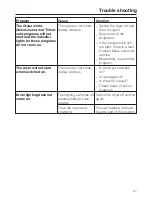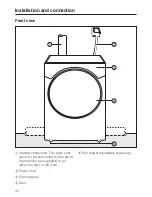
Calculating total duct length
Each of bends and differing
components of the dryer's venting
creates its own frictional resistance to
the flow of the exhaust air. This frictional
resistance is expressed in
a
comparative duct length
. The
comparative duct length indicates the
length of a smooth straight pipe (of the
same diameter), producing the same
resistance to air flow as the original
ducting component (Table I).
Adding together the comparative duct
lengths of all components reveals the
total duct length
. The total duct length
is a calculated value that compares
how long a smooth straight venting
pipe would have to be for the same air
flow.
Since an
internal pipe diameter
strongly affects flow's resistance, a vent
with a total duct length
exceeding 20
m
requires a larger diameter (Table II).
Procedure
1. Measure the distance requiring
straight ducting. Multiply this value
by the corresponding comparative
pipe length from
Table I
.
2. Determine the number of bends and
components required. Add their
comparative lengths together using
Table I
.
3. Add together all the comparative
lengths thus determined: Thus you
obtain the total duct length.
4. From
Table II
, determine which
internal duct diameter is required for
the total duct length.
Table I
Components
Comparative duct length
Flexible ducting
–
1 m laid straight
–
45° bend
(Bend radius = 0.25 m)
–
90° bend
(Bend radius = 0.25 m)
1.8 m
1.5 m
2.5 m
Vent hose(flexible or Alu-Flex)
–
1 m laid straight or 1 m straight
pipe
–
45° bend
(Bend radius = 0.25 m)
–
90° bend
(Bend radius = 0.25 m)
1.0 m
0.6 m
0.8 m
Wall vent kit or window vent kit
–
with grill insert
–
with non-return flap (hinged flap)
3.8 m
1.5 m
Non-return flap* for integration
into the vent ducting
(see section "
d
Vent collector
duct")
14.3 m
Flat duct (for stacked
arrangement)
11.0 m
Left or right dryer vent opening
1.0 m
* Miele accessory available on order
Table II
Maximum permissible
total duct length
Diameter required
20 m
40 m
100 m
100 mm
125 mm
150 mm
Installing the dryer vent
35
















































